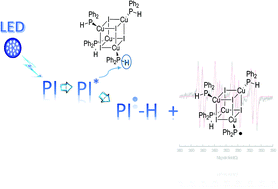Cubane Cu4I4(phosphine)4 complexes as new co-initiators for free radical photopolymerization: towards aromatic amine-free systems†
Abstract
The investigation of copper-iodide cubane derivatives as new co-initiators for the free radical polymerization (FRP) of acrylate monomers under mild irradiation conditions is described here for the first time. These tetranuclear Cu(I)-based complexes have the general formula, Cu4I4(phosphine)4, where phosphine is triphenylphosphine (Cu1) or diphenylphosphine (Cu2). In the presence of commercial Type II photoinitiators such as isopropylthioxanthone (ITX) or camphorquinone (CQ), this class of co-initiators achieves high final conversions of the reactive functional groups. A comparison between the aromatic amine, namely ethyldimethylaminobenzoate (EDB), used as a benchmark hydrogen donor, and these copper-based co-initiators is made, which demonstrates that the latter can be considered as valid, environmentally friendly alternatives to toxic aromatic amines. Markedly, photoluminescent materials can be generated thanks to the presence of cubanes linked to the polymer network.



 Please wait while we load your content...
Please wait while we load your content...